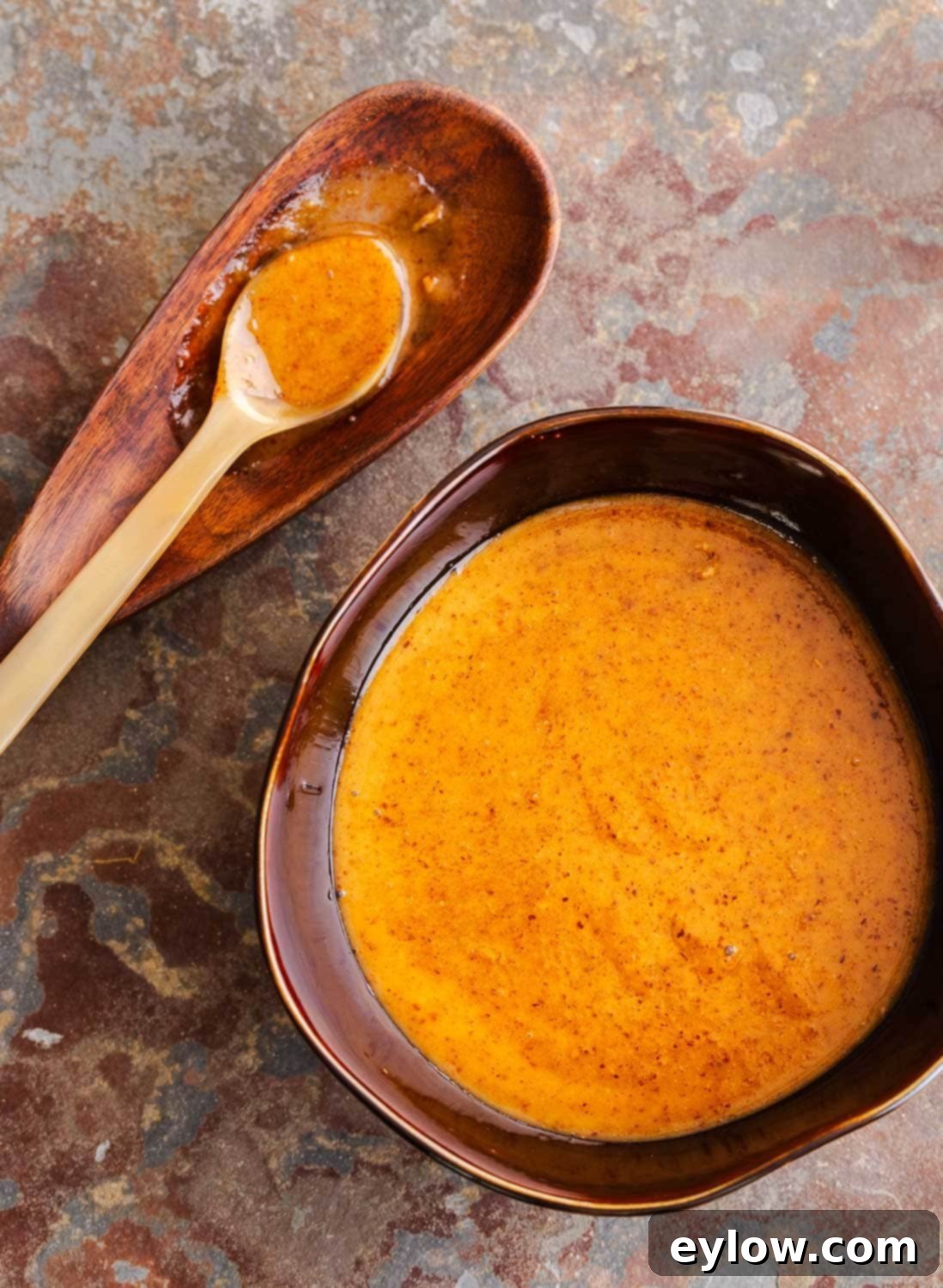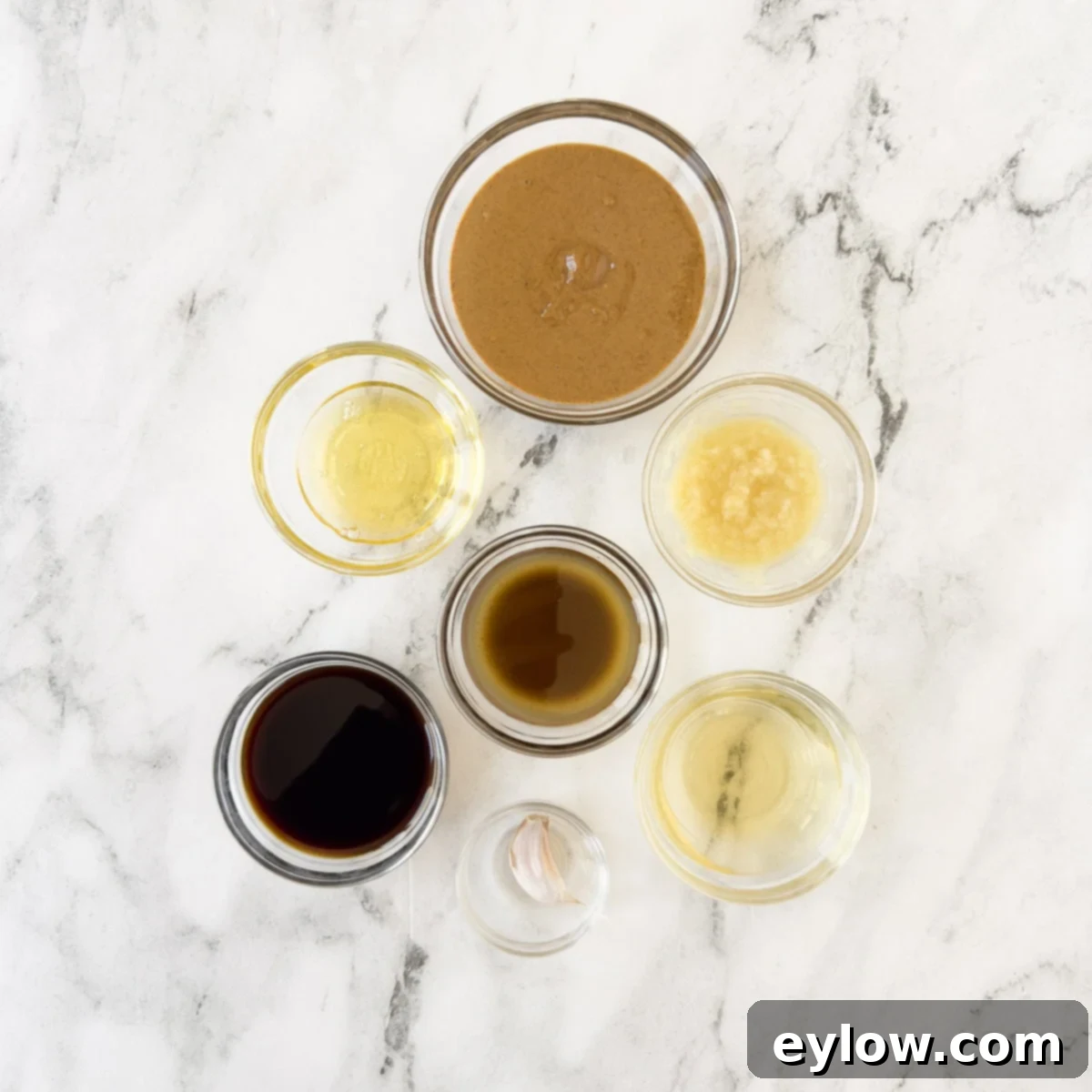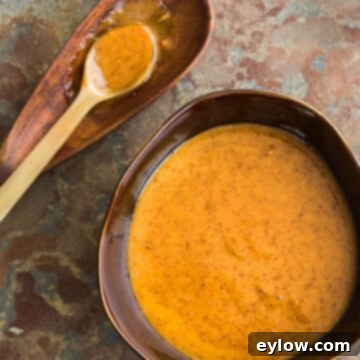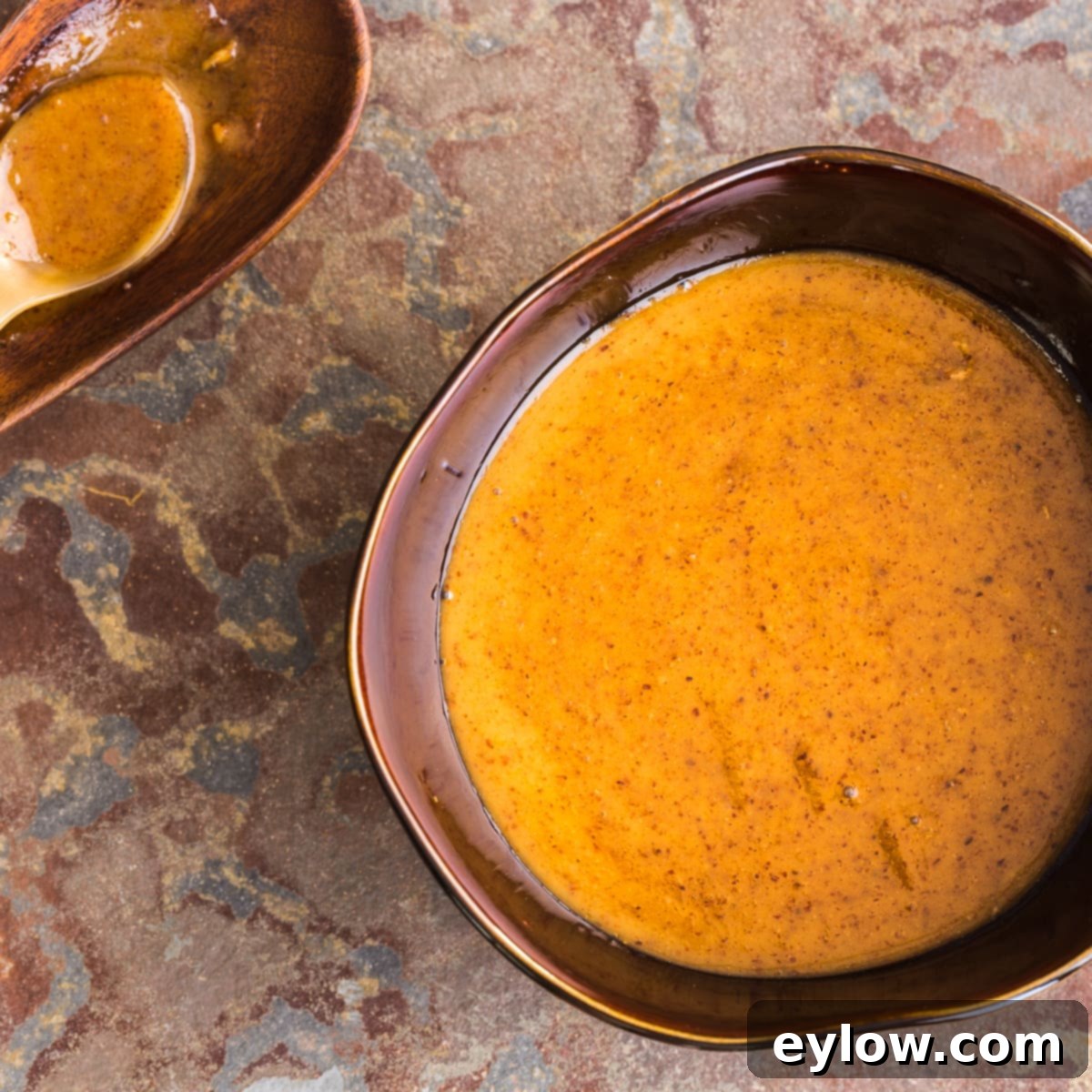Effortlessly Delicious: The Ultimate Creamy Almond Butter Asian Dipping Sauce (Gluten-Free & Versatile)
In the culinary world, a truly exceptional sauce can elevate any dish from ordinary to extraordinary. This creamy Asian dipping sauce is precisely that secret weapon your kitchen needs. Crafted with wholesome, natural almond butter, savory tamari (a fantastic gluten-free alternative to traditional soy sauce), bright rice vinegar, and a kick of fresh ginger, this sauce offers a symphony of bold, umami-rich flavors perfectly balanced with a subtle sweetness. What makes it even more remarkable? It’s a quick, no-cook recipe that comes together in mere minutes, making it an ideal choice for busy weeknights or impromptu gatherings.
Its versatility is unparalleled. Whether you’re looking for a luscious dip for crispy spring rolls, a vibrant dressing to tie together a fresh noodle bowl or salad, a savory marinade for grilled chicken, or a finishing drizzle for a wholesome grain bowl, this almond butter sauce effortlessly transforms every component it touches. It brings a cohesive, delicious Asian-inspired flair that will leave your taste buds craving more.

My journey to creating this delightful Asian-style sauce began with a desire for a healthier, yet equally flavorful, alternative to traditional peanut-based sauces. Almond butter provides an incredible creamy base, offering a slightly nutty, less pronounced flavor profile than peanuts, allowing the other Asian aromatics to truly shine. Blended with fragrant fresh ginger and garlic, rich sesame oil, tangy rice vinegar, and a touch of golden honey, this sauce achieves a perfect harmony of sweet, savory, and tangy notes. Its natural thickness is ideal for dipping, but it’s incredibly easy to adjust the consistency. Should you prefer a thinner, more pourable dressing, a simple whisk with a little warm water will yield a beautifully smooth, lighter texture.
This recipe is not just about taste; it’s about convenience and wholesome eating. It caters to various dietary needs, being naturally gluten-free (when using tamari) and dairy-free, and offers options for those with nut or soy allergies. It’s designed to be a staple in your kitchen, simplifying meal prep and adding a burst of flavor to an array of dishes.
Ready to discover the magic of this irresistible Asian dipping sauce? Let’s dive into what makes it a must-have, what you’ll need to create it, and all the delicious ways you can incorporate it into your cooking.
[feast_advanced_jump_to]Why This Asian Dipping Sauce Will Become Your Go-To Recipe
There are countless reasons why this particular Asian dipping sauce stands out and is bound to become a recurring star in your recipe repertoire. Its unique combination of simplicity, adaptability, and incredible flavor makes it a true kitchen hero.
- No Cooking Required: A True Time-Saver – Forget simmering, sautéing, or complex reductions. This sauce is a testament to culinary efficiency. All you need is a bowl and a whisk (or a blender for ultimate creaminess), and in mere minutes, you’ll have a perfectly smooth, ready-to-use sauce. This makes it an absolute lifesaver on busy weeknights or when you need a quick flavor boost without adding extra cooking time.
- Remarkably Versatile Flavor Profile – The beauty of this sauce lies in its adaptability. Its balanced sweet, savory, and tangy notes mean it pairs beautifully with an astonishing variety of dishes. It’s fantastic as a dipping sauce for fresh or fried spring rolls, an invigorating dressing for noodle bowls, a flavorful marinade or accompaniment for grilled chicken, shrimp, or tofu, and even a delicious drizzle over roasted vegetables or grain bowls. Its nuanced flavor complements rather than overpowers, allowing it to enhance a wide range of cuisines beyond just Asian dishes.
- Wholesome, High-Quality Ingredients – We believe that great flavor starts with great ingredients. This recipe prioritizes natural, wholesome components such as creamy almond butter, rich tamari, bright rice vinegar, and a touch of natural honey. These ingredients not only contribute to its superb taste but also offer beneficial nutrients, making it a healthier choice compared to many store-bought alternatives that can be loaded with artificial flavors and excessive sugars.
- Easily Made Gluten-Free & Dairy-Free – For those with dietary restrictions, this sauce is a dream come true. By using tamari instead of traditional soy sauce, it is naturally gluten-free. Furthermore, since it relies on almond butter and contains no dairy products, it is also completely dairy-free. This inclusivity ensures that more people can enjoy its incredible flavors without worry, making it an excellent option for entertaining guests with diverse dietary needs.
- Make-Ahead Friendly for Easy Meal Prep – Planning meals in advance just got easier. This robust sauce keeps exceptionally well in the refrigerator for several days, allowing you to prepare a batch at the beginning of the week. This means less stress during meal times and more delicious, ready-to-go flavor for your favorite dishes. Simply give it a good stir before serving, and you’re all set!
This Asian dipping sauce is especially perfect as an accompaniment to light and vibrant appetizers, such as colorful vegetable spring rolls, offering a rich, satisfying contrast to their fresh crunch.
Essential Ingredients for Your Creamy Asian Dipping Sauce
Creating this irresistible sauce requires just a handful of staple ingredients, each playing a crucial role in building its complex flavor profile. Opting for quality ingredients will make a noticeable difference in the final taste.

- Nut Butter: The Creamy Foundation – The star of our sauce is natural almond butter. It provides the luxurious, creamy texture and a subtle nutty base without being overpowering. When selecting, always choose natural almond butter with no added sugar, salt, or preservatives. Many brands will separate with oil on top; this is completely normal. Remember to stir it very well or reblend it before measuring to ensure a consistent texture for your sauce.
- Vinegar: For Brightness and Tang – Unseasoned rice vinegar is the ideal choice here. It imparts a delicate tang and brightness that cuts through the richness of the almond butter without introducing a strong, acidic flavor. Its mild profile is characteristic of many Asian sauces and helps balance the overall taste beautifully.
- Oil: The Aromatic Enhancer – Sesame oil, particularly toasted sesame oil, is crucial for achieving that authentic, signature Asian flavor. Its deeply nutty and aromatic notes are classic in this type of sauce. If you prefer a milder flavor or don’t have sesame oil, a neutral oil like avocado oil or MCT oil can be used. Melted coconut oil is another option, but be aware that it might cause the sauce to thicken more significantly when chilled, affecting its pourable consistency. A word of caution: avoid standard vegetable oils, which often contain unhealthy fats and can negatively impact the flavor and health benefits of your sauce. If you still have them in your pantry, it might be time to toss them!
- Soy Sauce Alternative: The Umami Depth – Low-sodium tamari is my preferred choice as it is naturally gluten-free and delivers a rich, savory umami depth. For those avoiding soy altogether, excellent alternatives include San-J No Soy Sauce (which remarkably mimics the flavor of traditional tamari) or coconut aminos. Coconut aminos offer a slightly sweeter, less intensely savory profile than tamari, so adjust other sweeteners accordingly if using. Always opt for low-sodium versions to better control the saltiness of your sauce.
- Sweetener: Balancing the Flavors – A touch of mild honey beautifully balances the savory and tangy notes, adding a pleasant sweetness. For those seeking a sugar-free option, liquid monk fruit-based sweeteners or sugar-free “honey” alternatives work wonderfully. Adjust the amount to your preference, as the sweetness level can significantly alter the overall taste.
- Ginger: The Warm Zing – Fresh ginger is a powerhouse of flavor, adding a warm, zesty, and slightly spicy kick that is quintessential in Asian cuisine. Finely grated fresh ginger offers the most vibrant flavor. In a pinch, a good quality jarred ginger puree can be used as a convenient alternative.
- Garlic: Aromatic Depth – Minced fresh garlic provides essential savory depth and an aromatic punch. For the best flavor, fresh garlic is highly recommended. If you’re really short on time or fresh garlic isn’t available, a small amount of garlic powder can be used, though it won’t offer the same vibrant intensity.
Chef’s Tip: Choosing Your Soy Sauce Option
The choice of soy sauce alternative is key for both flavor and dietary needs. Tamari is a widely available and excellent gluten-free option; always choose low-sodium to control the overall saltiness. Coconut aminos provide a soy-free alternative, but they tend to be a bit sweeter and less intensely savory, so you might adjust the honey in the recipe. For those avoiding both soy and gluten, San-J’s No Soy Tamari is a fantastic choice, delivering a surprisingly authentic flavor profile. If gluten is not a concern for you, a good quality low-sodium organic soy sauce is also perfectly acceptable.
This versatile almond butter sauce isn’t just for classic Asian dishes. It’s a fantastic way to dress up simpler preparations, such as glazing or serving alongside crispy chicken cutlets, adding a gourmet touch to an everyday meal.
Customizing Your Sauce: Substitutions and Creative Variations
One of the joys of homemade sauces is the ability to customize them to your taste and dietary preferences. This Asian dipping sauce is incredibly forgiving and open to various substitutions and creative twists.
- Nut Butter Swaps for Different Flavor Profiles – While almond butter is featured, feel free to experiment! Raw cashew butter offers a similarly creamy texture with a milder, slightly sweeter note. For a delightful sesame-forward twist, especially if you need a **nut-free option**, tahini (sesame seed butter) works wonderfully, though it will yield a different flavor profile, leaning more Middle Eastern or Mediterranean if other ingredients aren’t adjusted. Peanut butter is also an option, transforming the sauce into a classic Thai-style peanut sauce, which has a distinct flavor that many love.
- Vinegar Alternatives – If unseasoned rice vinegar isn’t readily available, apple cider vinegar can be a good substitute, offering a similar tang with a fruity undertone. White wine vinegar can also work in a pinch, providing a sharp acidity. Always taste and adjust, as different vinegars can vary in strength and flavor.
- Sweetener Choices – Beyond honey, you can use maple syrup for a rich, earthy sweetness (though it will impart its own distinct flavor). Agave nectar is another neutral-flavored liquid sweetener option. A word of caution: avoid sweeteners containing erythritol, as they may crystallize in the sauce over time, affecting its smooth texture.
- Add a Citrusy Brightness – For an extra layer of fresh, bright flavor, a splash of freshly squeezed lime juice or lemon juice can be a fantastic addition. Citrus notes often elevate Asian-inspired dishes and provide a welcome zest.
- Adjusting Sauce Texture: Thickness Control – This sauce is designed to be versatile in consistency. If you desire a thinner, more pourable dressing for salads or drizzling, simply whisk in a little warm water (start with a tablespoon at a time) until you reach your desired consistency. For a thicker, more robust dip, you can add a touch more almond butter or reduce the initial amount of oil slightly.
- Spice It Up! – If you enjoy a bit of heat, consider adding a pinch of red pepper flakes, a dash of sriracha, or a touch of chili garlic sauce to the mixture. Start with a small amount and increase to your preferred spice level.
- Fresh Herb Infusion – Fresh cilantro or green onions, finely chopped, can be stirred in just before serving for an aromatic garnish and an extra layer of fresh flavor.
Chef’s Tip: How to Revive Separated Almond Butter
Natural almond butter often separates, with oil rising to the top and a denser, solid layer at the bottom. Don’t throw it away! To fix this, simply scrape the entire contents of the jar into a food processor. Use a table knife or sturdy spatula to dig out the solidified portion at the bottom. Blend on high until the butter is completely smooth and creamy again. This takes just a minute or two and makes it far easier to measure accurately for recipes like this one, not to mention saving you money on expensive nut butter!
Crafting Your Delicious Asian Dipping Sauce: A Simple Guide
The beauty of this recipe lies in its utter simplicity. There’s no complex cooking or fancy equipment required, making it accessible to even the most novice home cooks. You’ll be amazed at how quickly you can create such a flavorful sauce!
Making this Asian dipping sauce is incredibly straightforward. The core process involves just two easy steps:

- Combine All Ingredients: Gather all the measured ingredients – the creamy almond butter, rice vinegar, chosen oil, tamari (or alternative), honey (or sweetener), fresh ginger, and minced garlic. Add them all into a small or medium-sized mixing bowl. Ensure your almond butter is well-stirred or reblended beforehand for a smooth start.

- Whisk Until Smooth: Using a whisk or a fork, vigorously stir all the ingredients together in the bowl. Continue mixing until the sauce is completely smooth and creamy, with no lumps of nut butter remaining. If you prefer, a small blender or food processor can also be used to achieve an even silkier texture, though it’s typically not necessary. Once blended, taste the sauce. This is your chance to adjust the flavors to your personal preference. You might want to add a little more ginger for an extra kick, a touch more garlic for depth, or another splash of honey to enhance the sweetness.
Chef’s Tip: Mastering Sauce Thickness for Any Dish
This delightful sauce is designed with adaptability in mind, allowing you to tailor its consistency to perfectly suit your culinary needs. As the recipe is written, it yields a beautifully drizzle-able consistency, which is ideal for pouring over noodle bowls or salads, or for lightly coating grilled proteins. If your preference leans towards a thicker, more robust dip, perfect for hearty appetizers or as a burger spread, simply stir in an additional teaspoon or two of almond butter. This will increase its body and richness. Conversely, if you envision a lighter, thinner dressing, a small splash of warm water, rice vinegar, or even a neutral oil will help loosen it to your desired pourability. Remember, the key is to taste as you go! Adjusting the consistency and flavors like ginger or garlic allows you to truly make this sauce your own, enhancing its appeal for a multitude of dishes. Don’t be shy about adding a little extra ginger if you’re a fan – it truly brightens the entire profile!
Creative Ways to Enjoy Your Versatile Asian Dipping Sauce
Once you’ve whipped up a batch of this flavorful almond butter Asian dipping sauce, you’ll find endless opportunities to incorporate it into your meals. Its robust yet balanced flavor profile makes it a fantastic addition to a wide array of dishes, from appetizers to main courses.

Here are some of our favorite ways to use this incredibly versatile Asian dipping sauce:
- Enhance Grilled Proteins: This sauce is a phenomenal complement to any grilled protein. Generously spoon it over grilled chicken (just like the delicious skewers pictured above!), shrimp kabobs, or even seared tofu. It adds a wonderful depth of flavor and keeps proteins moist and tender. You can also use it as a marinade before grilling for an even deeper infusion of taste.
- Transform Noodle Salads: For a refreshing and satisfying meal, thin the sauce slightly with a little warm water and toss it with cooked and chilled brown rice noodles. Add an assortment of finely chopped raw vegetables such as bell peppers, cucumbers, carrots, and cabbage for a vibrant, crunchy, and incredibly flavorful noodle salad that’s perfect for lunch or a light dinner.
- Elevate Seared Ahi Tuna: Drizzle this luscious sauce over perfectly seared Ahi tuna for a gourmet touch. The rich, savory notes of the sauce create a stunning contrast with the delicate flavor of the tuna, providing a bold and flavorful finish that will impress any diner.
- Revolutionize Your Burgers: Move beyond ketchup and mustard! Use this Asian dipping sauce as a unique and flavorful spread on grilled beef, chicken, or even air fryer burgers. It introduces an unexpected Asian-inspired twist that will make your burger experience truly memorable.
- Dress Up Salads: Thin the sauce to your desired consistency and use it as a vibrant dressing for your favorite green salads. It pairs exceptionally well with crisp greens, shredded cabbage, and a medley of colorful vegetables. It’s particularly fantastic as the dressing for my Asian cabbage salad recipe, providing a rich, creamy counterpoint to the crunchy textures.
- The Ultimate Veggie Platter Dip: Forget boring dips! Serve this creamy sauce alongside a colorful platter of raw vegetables such as carrot sticks, cucumber slices, bell pepper strips, and broccoli florets. It’s a healthy, flavorful, and incredibly satisfying option for entertaining or healthy snacking.
- Stir-Fry Booster: Add a tablespoon or two to your homemade stir-fries during the final minutes of cooking to thicken the sauce and infuse a rich, nutty flavor.
- Wrap and Sandwich Spread: Use it instead of mayo or other condiments in wraps, pita pockets, or sandwiches for a fresh, Asian-inspired flavor profile.
Storing Your Homemade Asian Dipping Sauce
One of the many convenient aspects of this particular recipe is how well it stores, making it an excellent candidate for meal prepping. Whether you’ve made a thick dip or a thinner dressing, this versatile sauce will maintain its quality and delicious flavor when kept properly in the refrigerator for up to a full week. To ensure maximum freshness and to prevent any odors from other fridge contents, store it in an airtight jar or container.
It’s important to note that when chilled, the sauce may naturally stiffen due to the almond butter and oil solidifying slightly. This is completely normal and easily remedied. Before using, simply let the sauce come to room temperature for about 15-30 minutes, then give it a good stir or whisk. If it still needs a bit of loosening to reach your desired consistency, you can add a small amount of warm water, a splash of rice vinegar, or a touch of neutral oil, stirring until smooth and perfectly pourable again.
Common Questions About Our Asian Dipping Sauce
We’ve gathered some frequently asked questions to help you make the most of this versatile and delicious Asian dipping sauce. If you have other questions, feel free to ask!
Absolutely, cashew butter is an excellent substitute for almond butter in this recipe. It offers a similarly creamy texture and a slightly milder, sweeter flavor profile. The overall taste of the sauce will be subtly different but equally delicious. Ensure your cashew butter is natural and unsweetened, just like the almond butter recommendation.
For those with nut allergies, you can successfully make this sauce using tahini, which is a paste made from sesame seeds. Using tahini will create a sauce with a distinct sesame-forward flavor, reminiscent of some Middle Eastern and Mediterranean sauces, but still perfectly delicious in an Asian context. Just be mindful that tahini can be quite rich, so you might want to adjust the oil content slightly or thin with a little extra water to achieve your desired consistency.
If you need to avoid soy, you have great alternatives for the tamari or soy sauce in this recipe. Coconut aminos are a popular choice; they offer a slightly sweeter flavor than tamari, so you might want to reduce the honey slightly. Another excellent option is San-J No Soy Tamari, which is specifically designed to mimic the flavor of traditional tamari without any soy content, providing a very close taste profile.
Yes, absolutely! This sauce is perfectly suited for making ahead, which is one of its greatest advantages for convenient meal preparation. Simply mix up a batch, transfer it to an airtight jar or container, and store it in the refrigerator for up to a week. When you’re ready to use it, just give it a good stir. If it has thickened too much in the cold, you can easily loosen it by adding a tiny bit of warm water or an extra splash of vinegar or oil until it reaches your preferred consistency. This makes it a fantastic staple to have on hand throughout the week.
📖 Recipe: Creamy Almond Butter Asian Dipping Sauce

Asian Dipping Sauce
Sally CameronIngredients
- ½ cup natural almond butter sub cashew butter
- 3 tablespoons unseasoned rice vinegar sub white vinegar
- 3 tablespoons neutral flavored oil or sesame oil coconut oil or MCT oil
- 3 tablespoons low sodium tamari or soy sauce
- 1 ½ tablespoons honey
- 1 ½ tablespoons pureed ginger from jar or finely zested fresh peeled ginger
- 1 large garlic zested fine
Instructions
- Place all ingredients in a small bowl and stir together until completely smooth. The sauce can be used thick for dipping or thinned out with a little warm water for drizzling or dressing salads. Taste and adjust seasonings (more ginger, garlic, or honey) as desired.
Notes
- Grilled Proteins: Spoon generously over grilled chicken or shrimp kabobs for an instant flavor boost.
- Noodle Salad: Thin the sauce slightly and toss with cooked, chilled brown rice noodles, fresh herbs, and a medley of chopped raw vegetables for a refreshing meal.
- Ahi Tuna: Drizzle over perfectly seared Ahi tuna for a bold, flavorful, and elegant finish.
- Burgers: Use it as a unique and delicious spread on grilled burgers or air fryer chicken patties for an Asian-inspired twist.
- Salads: Thin to your desired consistency and use as a vibrant dressing for your favorite salads, particularly a crunchy Asian Cabbage Salad.
- Veggie Platter: Serve as a creamy and flavorful dip for an assortment of raw vegetables.
